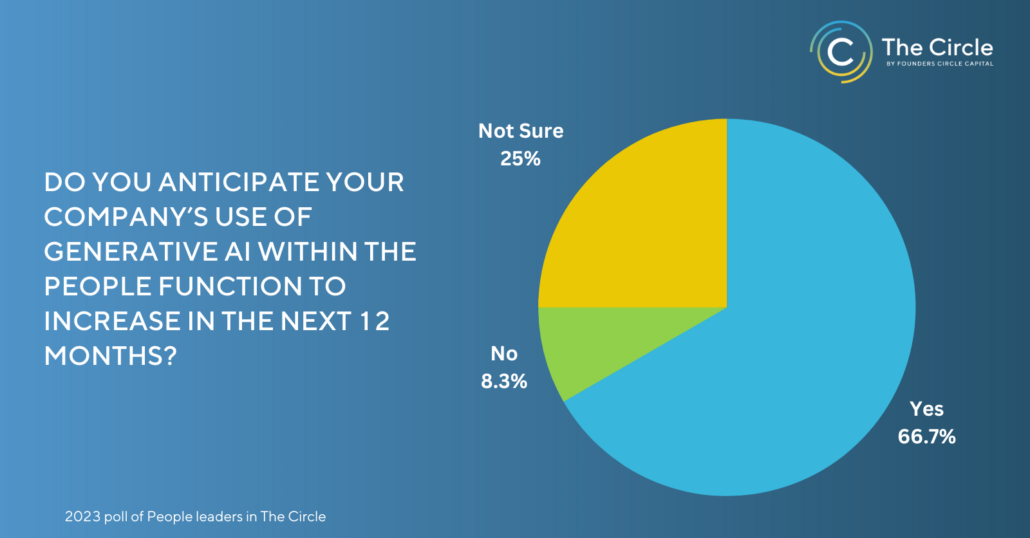Trending
Top CFO Tactics for Reducing Software Spend & Consolidating Systems
/in I'm Looking for Strategic Planning Tips, Software Stack for Growth Companies, Systems & Processes, Trending, Featured on Home/by Matt McCue4 Considerations To Craft Your Company’s Equity Strategy
/in I Need to Retain my Top Performers, Secondary Liquidity, Developing Your Team, Talent, Trending, Equity & Compensation, Featured on Home/by Matt McCueAdvancing Your Influence: Strategies for CFOs
/in CFO Leadership, Leadership & Vision, Developing Your Team, Talent, Trending, Featured on Home/by Matt McCueShare this entry

Generative AI in HR: Opportunities, Risks, and Policy Considerations
People leaders discuss the impact of generative AI
With the launch of ChatGPT-3, generative AI has quickly demonstrated the potential to disrupt almost every business function, including HR. As Josh Bersin wrote: “Virtually every decision we make about people (who to hire, who to promote, how much to pay someone, how to develop someone) is based on judgment, experience, personal bias, and some amount of data. And it’s difficult, imperfect, and always subject to debate.” Generative AI can give People leaders the power to make decisions faster based on millions of data points and help automate some of the manual tasks that consume their work.
It’s no surprise that people leaders are already high on the generative AI adoption curve. A poll of executives in The Circle revealed that 66% anticipate increasing their use of generative AI in the next 12 months. However, as People leaders explore the potential benefits of generative AI across talent acquisition, performance management, and other HR operations, they’re also observing potential compliance, data privacy, and ethical issues that come with using AI automation.

Recently, we invited executives in The Circle to share their thoughts on and use cases for generative AI within the People function, and to learn about some of the underlying benefits and risks from Omer Tene (Partner at Goodwin’s Technology group and Data, Privacy & Cybersecurity practice) and Aravind Bala (Cofounder & CTO of SeekOut, an AI-powered talent recruitment and management platform and Founders Circle portfolio company).
A “Super Power” for HR Professionals
A steady wave of hype around generative AI has contributed to some misconceptions about what it can actually do. Therefore, Aravind – who has been in the AI space for over 20 years – helped ground the conversation with some of the first principles of generative AI.
Generative AI uses learning language models (LLM) to identify patterns and structures within existing data and generate new content with human-like quality. In recent months, we’ve seen this applied to AI-generated text, image, or audio content created with tools like ChatGPT. Like a human, generative AI is always learning and refines its algorithm over time as it ingests more data.
With the latest advancements to LLMs, Aravind sees four key advantages to generative AI:
- Knowledge storage – LLMs like ChatGPT draw data from massive wells of knowledge (essentially the entire Internet up to a certain cutoff date). This effectively gives the user fingertip access to the entire knowledge-based of public-available information.
- Streamlined Content Generation – Generative AI has been lauded for its ability to produce human-like written, audio and visual content within seconds and when given a simple prompt.
- Data Comprehension and Synthesis – Generative AI models can be used to distill complex data or ideas into simple outputs. For example, an LLM can be trained to scan large multi-page documents and provide answers to very specific queries instantly.
- Using Tools With Greater Efficiency – Perhaps the most exciting frontier of generative AI is its ability to use existing tools or perform complex tasks like writing code, programming software, or training other machine learning models.
“Generative AI is almost a superpower. It gives us the ability to perform tasks quicker and get answers that are presented without an agenda or bias. But to get the best use of generative AI, you have to learn how to give it good instructions.” – Aravind Bala (Cofounder & CTO of SeekOut)
How Generative AI Can Transform HR
HR involves a lot of complex decisions and manual tasks that are ripe for automation through generative AI. Throughout the discussion, we heard a number of different ways in which People leaders are already using generative AI, including:
- Writing, wordsmithing, and grammar-checking job descriptions, employee communications, and onboarding materials
- Creating first drafts of new company policies
- Scanning resumes to pre-screen candidates
- Conducting initial interviews via chatbot
- Evaluating facial expressions and speech patterns during video interviews
- Creating slide decks and Excel spreadsheets
- Developing Learning & Development training materials
- Improving writing and communication skills
Generative AI can automate and solve many HR complexities, but our experts were adamant that it is unlikely to replace actual HR professionals. “Human empathy and emotional intelligence are central to the role of an HR professional,” said Omar. Generative AI is a tool for efficiency, added Aravind: “It can be used to help upskill your team and give them the flexibility to do things that they may have not been able to do before.”
The Risks of Generative AI in HR
Of course, there are a number of risks that People leaders need to consider when implementing generative AI at their organization.
- Regulatory/Compliance Risk – Since the launch of ChatGPT-3, a regulatory response has been building at the state and federal levels. Already several states have passed laws around the use of generative AI for collecting, storing and using data. Recently, the U.S. Equal Employment Opportunity Commission (EEOC) came out with a notice highlighting their concerns around bias and discrimination violations when using AI to select new employees, monitor performance, and determine pay or promotions.
- Third-Party Risk – Even if organizations adhere to data privacy and compliance rules, their third-party vendors or the generative AI tools they’re using might not have the same standards.
- Data Storage and Use – Omer noted that there are general risks around copyright infringement and exposure of confidential data when using generative AI tools. “There can be heightened risk of exposing personal information or proprietary company information that is used to train an LLM and could perhaps be accessible by other customers of the same vendor,” explained Omer.
“A decision rendered by a third-party AI tool doesn’t excuse an employer from complying with state regulations or laws that govern bias and discrimination. There is complexity here because sometimes an employer doesn’t know why or how a decision is being rendered or what factors go into it. But they are liable for it.” – Omer Tene (Partner at Goodwin’s Technology group and Data, Privacy & Cybersecurity practice)
As the risks associated with generative AI grow, Omer encourages companies to start developing an AI policy that governs data privacy, copyright, protection of corporate assets, vendor management, governance, and accuracy. A poll found that roughly 42% of companies represented during the discussion already have or are developing a generative AI use policy.
In addition to a robust policy, HR professionals will need to maintain oversight on AI-assisted decisions around hiring, compensation, performance and more.
The Takeaway:
As the landscape of generative AI continues to evolve, many People leaders are actively exploring the productivity benefits while attempting to mitigate the risks. Having a firmwide strategy and policy in place can help organizations get the most out of this revolutionary technology, while Learning and Development teams can help educate and provide context to generative AI models to yield better results.
Apply to join The Circle and gain access to a private leadership community of CXO peers that regularly exchange ideas, insights, and support.
Related Blog Posts

4 Strategies for Responding to Glassdoor Reviews

Generative AI in HR: Opportunities, Risks, and Policy Considerations




